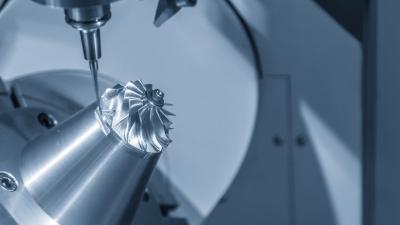
Kistler is following up its collaboration with Productive Machines Ltd by offering a new service for milling applications. It uses specialized software for combined analysis of data from physical measurements and NC machines. The benefits: optimized cutting parameters that help reduce chatter vibrations, improve the quality of manufactured parts, and cut overall costs.
In machining applications, unwanted vibrations on structures cause multiple negative effects. They can impact component quality (dimensions, surface, etc.), limit productivity, and decrease tool life – leading to faulty parts and additional reworking as well as higher costs for materials, tools, machines and engineers. To avoid these problems, Kistler is now offering a new milling optimization service in collaboration with Productive Machines Ltd, the UK-based cutting force experts.
The basis for this innovative service is a dynamic stiffness analysis of the machine tool. The physical optimization phase (known as the ‘tap test’) can be accomplished with impulse hammers and accelerometers from Kistler; this is followed by an analysis of the customer’s NC program, performed with new software from Productive Machines. All the acquired data is then processed to create a new NC program which, once installed, ultimately leads to better cutting performance, longer tool lifetimes and higher OEE – to name just a few benefits.
Significant improvements across diverse machining applications
Although the milling optimization service has only been available on the market for a short time, customers in many industries have already discovered its major advantages. Successful use cases include applications in the automotive, aerospace, moldmaking, precision parts and medical technology sectors. Some examples: for a French car manufacturer facing challenges with a machining process for a gearbox housing, the optimization service provided a solution that led to shorter cycle times and reduced tool wear. Also thanks to the new offering, an aerospace supplier based in Spain benefited from less chatter, fewer damaged parts and overall cost savings of 25 percent. And last but not least, a UK-based mill/turn specialist was able to optimize production of an aerospace part with the help of the new service: in this case, applied maximum forces decreased from 2,000 to 1,000 N and cycle times were shortened by 13 percent.
Fully digital delivery available
The new milling optimization service is available either onsite (when experts from Productive Machines visit the customer) or remotely in digital form via a credit-based online platform. Customers who choose the remote option conduct the dynamic stiffness analysis themselves, and then upload the CAM files to the platform. Buelent Tasdelen, Business Development Manager at Kistler, comments: “Our new milling optimization service will benefit moldmakers, machine builders, manufacturers and OEMs in many industries: it gives them exactly what they need to improve their machining processes. By largely eliminating vibration, customers enjoy advantages such as higher product quality, longer tool lifespans and shorter cutting times – so they can significantly boost their productivity and OEE while cutting their production costs.”
Contact Details
Related Glossary Terms
- chatter
chatter
Condition of vibration involving the machine, workpiece and cutting tool. Once this condition arises, it is often self-sustaining until the problem is corrected. Chatter can be identified when lines or grooves appear at regular intervals in the workpiece. These lines or grooves are caused by the teeth of the cutter as they vibrate in and out of the workpiece and their spacing depends on the frequency of vibration.
- computer-aided manufacturing ( CAM)
computer-aided manufacturing ( CAM)
Use of computers to control machining and manufacturing processes.
- cutting force
cutting force
Engagement of a tool’s cutting edge with a workpiece generates a cutting force. Such a cutting force combines tangential, feed and radial forces, which can be measured by a dynamometer. Of the three cutting force components, tangential force is the greatest. Tangential force generates torque and accounts for more than 95 percent of the machining power. See dynamometer.
- dynamic stiffness
dynamic stiffness
Measure of a machining system’s ability to dampen vibration from a forced input. If the dynamic stiffness of a system is not sufficient to dampen vibration, chatter occurs. See static stiffness; stiffness.
- gang cutting ( milling)
gang cutting ( milling)
Machining with several cutters mounted on a single arbor, generally for simultaneous cutting.
- milling
milling
Machining operation in which metal or other material is removed by applying power to a rotating cutter. In vertical milling, the cutting tool is mounted vertically on the spindle. In horizontal milling, the cutting tool is mounted horizontally, either directly on the spindle or on an arbor. Horizontal milling is further broken down into conventional milling, where the cutter rotates opposite the direction of feed, or “up” into the workpiece; and climb milling, where the cutter rotates in the direction of feed, or “down” into the workpiece. Milling operations include plane or surface milling, endmilling, facemilling, angle milling, form milling and profiling.
- numerical control ( NC)
numerical control ( NC)
Any controlled equipment that allows an operator to program its movement by entering a series of coded numbers and symbols. See CNC, computer numerical control; DNC, direct numerical control.
- stiffness
stiffness
1. Ability of a material or part to resist elastic deflection. 2. The rate of stress with respect to strain; the greater the stress required to produce a given strain, the stiffer the material is said to be. See dynamic stiffness; static stiffness.
